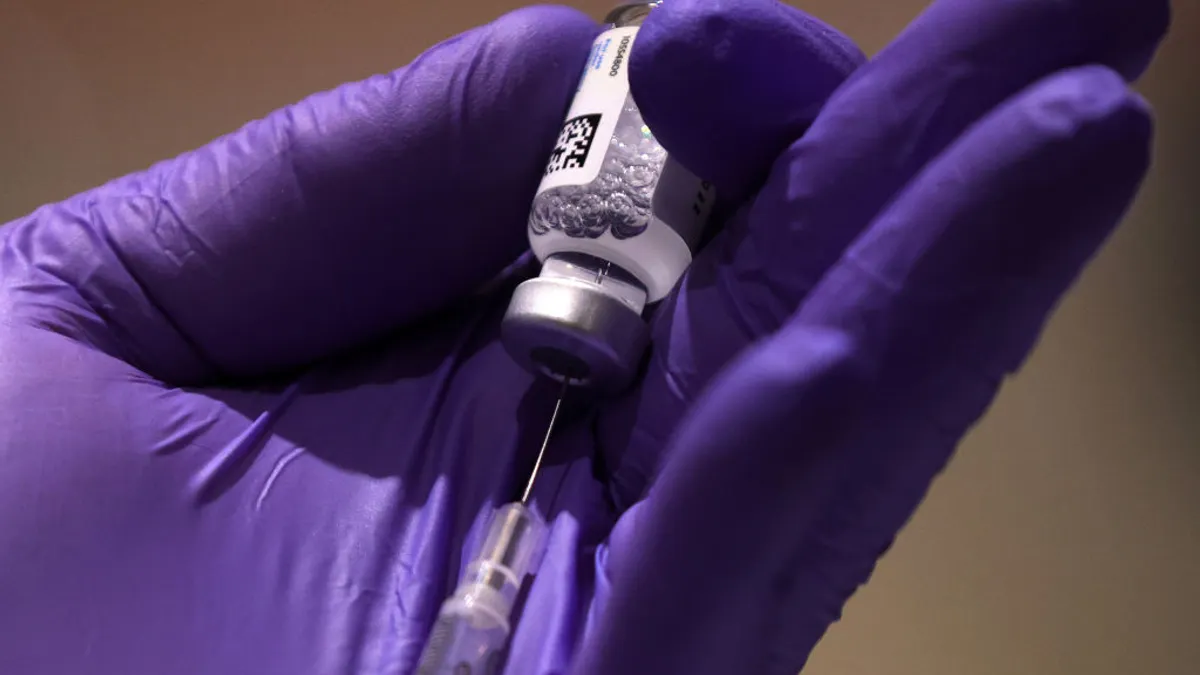Sarepta Therapeutics has followed a natural progression from its focus on RNA technology to the world of gene therapies, filing for U.S. regulatory approval of its first one-time treatment for Duchenne muscular dystrophy at the end of November.

If approved, SRP-9001, would be the first gene therapy for the muscular degenerative disease known as DMD and is slated for complete evaluation under the accelerated approval path by the end of May 2023.
The road to this potential "cure" for DMD has been a culmination of scientific persistence and a long career in incremental successes in the genetic field, said Louise Rodino-Klapac, chief scientific officer, executive vice president and head of R&D at Sarepta.
And the big step for the company is one that holds a great deal of promise for patients outside of the already groundbreaking RNA treatments Sarepta currently markets for the disease — Exondys 51, Vyondys 53 and Amondys 45. DMD is caused by a mutation that leads to the absence or dysfunction of a protein called dystrophin, which gene therapies can reset by creating functional dystrophin in patients with the disease. This gene therapy in particular adds a copy of the missing gene for potentially permanent rewiring.
"Our RNA technologies that are approved target specific exons — it's about collectively 30% of Duchenne patients with those mutations," Rodino-Klapac said. "The gene therapy approach is agnostic to mutation, and you're delivering a small functional version of the dystrophin gene to all muscle, cardiac and skeletal for a potentially lifelong benefit."
"I've been in the space for almost 20 years, and where we are today is a tremendous stride from where we were back then."

Louise Rodino-Klapac
CSO, executive vice president and head of R&D, Sarepta.
While the FDA reviews Sarepta's previous mid-stage data, which saw delays due to mixed results, the company is conducting a late-stage study it plans to read out at the end of 2023, months after the agency is due to make a decision.
Here, Rodino-Klapac discusses the potential for a gene therapy in the DMD treatment landscape, the development pathway the company took to get here and what persistence means for leaders of cutting-edge science where success is hard-fought.
This interview has been edited for brevity and style.
PHARMAVOICE: DMD has been your specialty with three commercial products on the market. Can you talk about the current treatment landscape?
LOUISE RODINO-KLAPAC: Duchenne is a devastating disease, where boys are often diagnosed between the ages of three and five and then progressively degenerate, often with early deaths in the mid-20s from cardiac respiratory failure. And so there's been a huge push in the biotechnology industry to find treatments for Duchenne. As far as the genetic disease, it's very well described, and we know that the DMD gene is affected. And so there's been multiple strategies to ameliorate the disease. Since Sarepta has gotten the approvals of the RNA drugs, that's led to a keen interest in the space, which is great for patients. I think there are over 50 different companies working on Duchenne right now. It's a huge treatment landscape.
What lessons did you take from your RNA medications into this gene therapy development program?
Quite a bit. From the RNA development we learned a lot about the natural history of the disease, which helps us to inform the way we design our clinical trials, but then also about levels of dystrophin. Whether you're using exon skipping or gene therapy, you're looking at how levels of dystrophin lead to clinical benefit. And so in both those ways, from the dystrophin production and natural history of the disease, we learned a lot from RNA.
Generally speaking, the development of a gene therapy is such a different beast from that of other treatments. Can you talk about the challenges there and the unique hurdles you need to overcome on your way to regulatory approval?
I've been in the space for almost 20 years, and where we are today is a tremendous stride from where we were back then. With gene therapy, one of the hurdles was being able to manufacture enough to deliver to the entire body. With Duchenne, we're trying to treat the largest system in the body, which is muscles — about 40% of the body mass is muscle. It's difficult to make enough and be able to deliver it effectively so this is a one-time treatment. After you deliver the gene therapy, patients develop antibodies and at this point you can't re-treat (the patient), although we're working on ways to do that.
We've been gradually overcoming every challenge of gene therapy and getting to a good place with overall favorable safety and, so far, very encouraging and efficacious results.
When overcoming these gene therapy challenges, do you remember any 'eureka' moments of coming up with a solution that would get you over a certain hill?
It's been a series of moments. For SRP-9001, selecting the RH74 vectors versus others and realizing that it distributes into muscle extremely well was important. There's a lot of work that went into that, and then the selection of the promoter to target the heart and skeletal muscle. So I think it's a series of those decisions and getting manufacturing on pace — it's all of those things collectively.
As you run your latest trial, what are the most important conversations you're having both internally and with the FDA?
We certainly had discussions with the FDA about the design of that trial, but importantly, we have collectively about 100 patients’ worth of data with our construct, including results showing benefits in three studies with results for some patients out to four years.. So we're in a very good place in terms of the data that we have. And we're using the accelerated approval pathway to get to patients as quickly as possible.
There were some early warning signs in terms of adverse events from early-stage trials. Those have been resolved, but can you talk about that process and how you investigate potential setbacks and then move forward?
We've seen adverse events, but they've been very manageable. The most events we've seen in terms of numbers have been nausea and vomiting. We do have some liver enzyme elevation, but once we modified our steroid protocol, those were reduced. We've been fortunate in the management of our profile, which greatly favors the benefit-risk. There have been other programs that have suffered more setbacks in terms of adverse events.
With your phase 3 pivotal study slated to read out by the end of next year, what else is next for Sarepta?
Certainly the next six months are focused on the review period with the FDA, but at the same time, we have a whole pipeline of programs we're moving along. We're using the same platform technology that we've developed for SRP-9001 in limb-girdle muscular dystrophies, so we're looking forward to additional trials there and to bring those forward as quickly as we can to patients. And we have additional RNA targets as well as gene editing, so it's obviously an exciting time. And we're balancing all of the programs as best we can to bring the biggest benefit to patients.
What are some of the most important qualities for a leader in overcoming the challenges in the development of gene therapies and the like?
These are things that are near and dear to my heart, and I think as you evolve as a leader, one of the challenges is getting good at being used to failure. Scientists for the most part are used to failure. When something doesn't go quite as you expected, being able to take it as a challenge and be able to react to it quickly and pivot and make changes is critical — things that we perceive as failures are often telling us something unique and can lead to serendipitous findings. That's the approach I've taken and try to guide my team to. As a leader, we cherish the opportunity to make sure the next generation of leaders are able to show what they can do and to give them the space to do it without micromanaging.




















